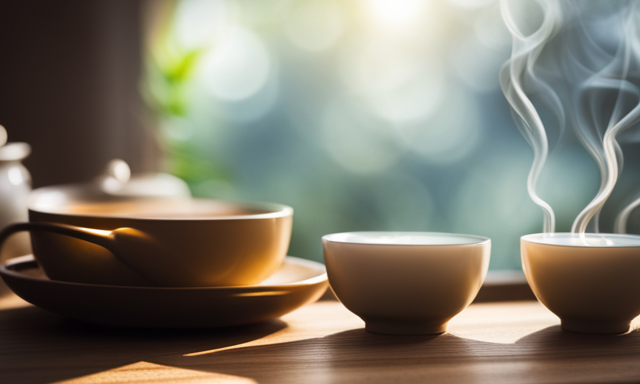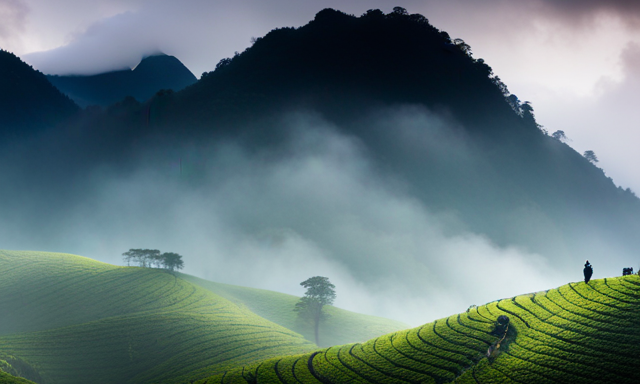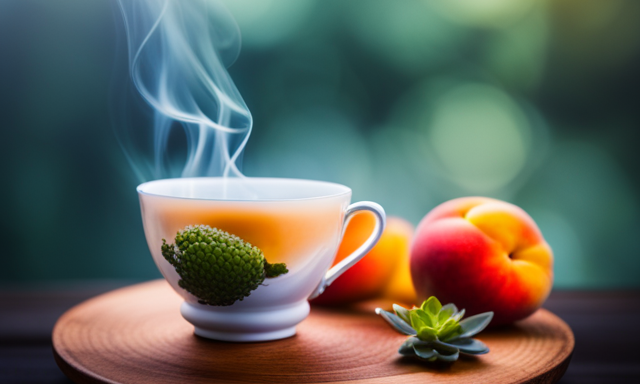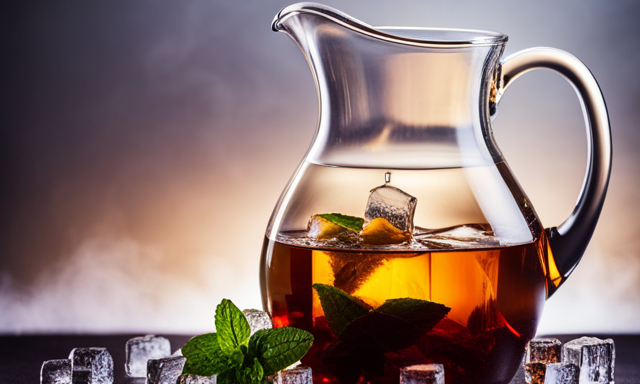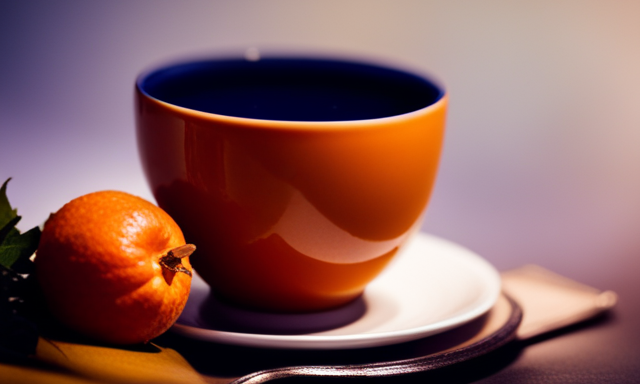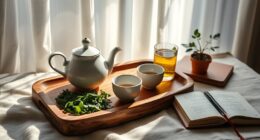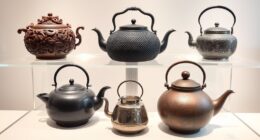Oolong tea, a true work of art, is made from the leaves of the Camellia Sinensis plant. This extraordinary tea is a testament to the skill and craftsmanship of tea processors, who carefully pluck, wither, oxidize, and roast the leaves to perfection.
The result is a tea that is neither fully black nor fully green, but a beautiful balance of both. What sets oolong tea apart is the role of terroir, the unique combination of soil, climate, and geography, which gives each variety its distinctive flavor profile.
From the floral and fruity notes of Tie Guan Yin to the rich and toasty flavors of Da Hong Pao, there is an oolong tea to suit every palate. So, join me on this journey to discover the secrets behind what makes oolong tea so enchanting.
Key Takeaways
- Oolong tea is made from the leaves of the Camellia Sinensis plant, with a unique partial oxidation process.
- The cultivation and harvesting methods of oolong tea are crucial for its flavor and quality, with varieties such as Qingxin, Tieguanyin, and Da Hong Pao having distinct characteristics and flavors.
- The art of tea processing involves withering, oxidation, roasting, and fermentation, which all contribute to the unique taste and aroma of oolong tea.
- The flavor profile of oolong tea is influenced by the terroir, including soil, climate, and geography, with different regions producing different flavors, ranging from floral and fruity to bolder and more roasted.
The Origin of Oolong Tea
Oolong tea, with its origins in China, is made from the leaves of the Camellia sinensis plant. It undergoes a unique partial oxidation process. The history of oolong tea dates back centuries and holds significant cultural significance in Chinese tradition.
The name ‘oolong’ translates to ‘black dragon’ in Chinese. This name symbolizes the long, twisted appearance of the tea leaves. Oolong tea is known for its complex flavors, ranging from fruity and floral to woody and toasty. This makes it a popular choice among tea connoisseurs.
The unique partial oxidation process of oolong tea involves allowing the leaves to oxidize anywhere from 8% to 80%. This results in a tea that falls between green tea and black tea in terms of flavor and color.
Moving on to the subsequent section about the tea plant, Camellia sinensis…
The Tea Plant: Camellia Sinensis
When it comes to oolong tea, the variety of the tea plant used is important. Camellia Sinensis is the specific plant that is cultivated for oolong tea production.
The cultivation and harvesting methods of this plant also play a crucial role in the flavor and quality of the tea.
Varieties of Camellia Sinensis used for Oolong Tea
The different varieties of Camellia Sinensis used for Oolong Tea bring a harmonious blend of flavors, enticing the taste buds and captivating the senses. Oolong tea production techniques vary depending on the specific variety of Camellia Sinensis used. Three popular varieties used for Oolong tea are Qingxin, Tieguanyin, and Da Hong Pao. Each variety has its own distinct characteristics and flavors, making the world of Oolong tea diverse and exciting.
| Variety | Flavor Profile | Production Region |
|---|---|---|
| Qingxin | Floral and fruity with a smooth finish | Taiwan |
| Tieguanyin | Subtle orchid aroma with a mellow taste | Fujian, China |
| Da Hong Pao | Robust and earthy with a hint of spice | Wuyi Mountains, China |
These varieties are carefully cultivated and harvested using traditional methods, ensuring the highest quality leaves are selected. Moving forward, let’s delve into the fascinating world of cultivation and harvesting methods, which play a vital role in the creation of exceptional Oolong teas.
Cultivation and Harvesting Methods
To cultivate and harvest Oolong tea, you’ll need to carefully tend to the Camellia Sinensis plants and use specific techniques to ensure the best quality leaves are picked.
The cultivation techniques for Oolong tea involve maintaining the right balance of sunlight, shade, and moisture. The plants are often grown at higher elevations, where the cool climate and misty conditions enhance the flavor and aroma of the leaves.
Harvesting practices for Oolong tea are meticulous, with only the top two or three leaves and the bud being plucked by hand. This selective picking ensures that the leaves are at their optimal stage of growth and have the right combination of flavors.
These cultivation techniques and harvesting practices are essential in achieving the distinct taste and characteristics of Oolong tea.
Moving on to the art of tea processing…
The Art of Tea Processing
When it comes to tea processing, two key steps that play a vital role in determining the flavor and aroma of the final product are withering and oxidation.
Withering involves allowing the freshly picked tea leaves to lose moisture, which helps to soften them and prepare them for further processing.
Oxidation, on the other hand, is the process where the tea leaves are exposed to air, causing chemical reactions that give rise to the unique flavors and colors of different types of tea.
Another important step in tea processing is roasting, which involves heating the tea leaves to stop the oxidation process and enhance their flavors.
Lastly, fermentation is a process where tea leaves are allowed to undergo controlled microbial activity, which further develops the taste and aroma of the tea.
Withering and Oxidation
Once the tea leaves have been harvested, you’ll be amazed at the transformation they undergo during the withering and oxidation process.
The withering methods used in oolong tea production involve exposing the leaves to air and sunlight, which helps to reduce their moisture content. This is done carefully to ensure that the leaves do not become overly dry or brittle.
During the oxidation process, the leaves are allowed to undergo controlled exposure to oxygen, which causes chemical reactions that result in the development of unique flavors and aromas. This step is crucial in creating the characteristic taste of oolong tea.
As the leaves wither and oxidize, they undergo significant changes in color, texture, and flavor. This prepares them for the next stage of tea processing, which involves roasting and fermentation, where the flavors continue to develop and intensify.
Roasting and Fermentation
The next step in the process involves roasting and fermenting the leaves, which enhances the flavors and intensifies the aromas.
Roasting techniques vary depending on the desired outcome, with some teas being lightly roasted to maintain a delicate flavor profile, while others are heavily roasted to develop a rich and robust taste.
The fermentation process, on the other hand, allows the tea leaves to undergo controlled oxidation, which alters their chemical composition and creates complex flavors. During fermentation, the leaves are exposed to moisture and heat, encouraging the development of unique characteristics.
It is important to note that the duration of fermentation greatly impacts the final taste of the tea.
The combination of roasting and fermentation ultimately contributes to the diverse range of flavors found in oolong tea.
Moving forward, the role of terroir in oolong tea flavor will be explored, examining how factors like climate and soil influence the taste of the tea leaves.
The Role of Terroir in Oolong Tea Flavor
To truly appreciate the unique flavor of oolong tea, you need to understand how the terroir, or the combination of soil, climate, and geography, plays a crucial role in its development. The terroir impact on oolong tea is significant, as it directly influences the flavor profile of the tea leaves. Different regions and environments result in distinct flavors and characteristics. For example, oolong tea grown in mountainous areas with cooler climates tends to have a floral and fruity taste, while those cultivated in lower altitudes with warmer temperatures may exhibit a bolder and more roasted flavor. To illustrate the variety in flavors, consider the following table:
| Terroir | Flavor Profile |
|---|---|
| Mountainous | Floral and Fruity |
| Lower Altitude | Bold and Roasted |
Understanding the role of terroir in oolong tea flavor allows us to appreciate the intricate nuances that make each cup of oolong tea unique. In the subsequent section, we will explore the distinctive taste of oolong tea.
The Distinctive Taste of Oolong Tea
The distinctive taste of oolong tea is influenced by several factors. First, the flavor profiles of oolong teas can vary widely. This is due to the different tea plant varieties used, as well as the growing conditions in which the tea is cultivated. Additionally, the processing methods employed during production also contribute to the taste. Oolong teas can exhibit notes of flowers and fruits, as well as hints of toasty and nutty flavors.
However, it’s important to note that the taste of oolong tea is not solely determined by the tea itself. Brewing techniques also play a crucial role in bringing out the flavors. The water temperature used for steeping, the duration of the steeping process, and even the type of vessels used can all impact the final taste of the tea.
To fully appreciate the distinct taste of oolong tea, it is worth experimenting with different brewing methods. By adjusting these variables, you can unlock the full potential of this delightful beverage and create a flavor profile that suits your preferences.
Now, let’s move on to explore the fascinating health benefits of oolong tea.
Oolong Tea’s Health Benefits
Oolong tea offers a treasure trove of health benefits waiting to be discovered. One of the most sought-after benefits is its potential to aid in weight loss. Studies suggest that oolong tea can increase metabolism and fat oxidation, making it a valuable addition to a healthy diet and exercise routine.
Additionally, oolong tea has positive effects on mental health. The combination of caffeine and L-theanine in oolong tea can promote relaxation and improve focus and alertness. These benefits make oolong tea a popular choice for those seeking mental clarity and stress relief.
As we transition to the subsequent section about brewing oolong tea, it’s important to consider these health benefits and how they contribute to the overall enjoyment of this delightful beverage.
Brewing Oolong Tea: Tips and Techniques
Are you ready to unlock the secret to brewing the most mesmerizing and mouthwatering cup of oolong tea that will have you savoring every sip? Brewing oolong tea is an art that requires precision and knowledge of the right techniques.
The first step is to choose the right water temperature, as brewing at too high or too low a temperature can affect the flavor. For oolong tea, the recommended temperature is around 195°F to 205°F (90°C to 96°C).
Next, steep the leaves for about 3 to 5 minutes, depending on your preference for a lighter or stronger flavor. Oolong teas have a wide range of flavor profiles, from floral and fruity to toasty and nutty. Experiment with different brewing times and water temperatures to discover your favorite flavor.
Now, let’s move on to explore the exciting world of oolong tea varieties and blends.
Oolong Tea Varieties and Blends
When it comes to oolong tea varieties and blends, there are two popular options that come to mind: Tie Guan Yin, also known as Iron Goddess of Mercy, and Da Hong Pao, also known as Big Red Robe.
Tie Guan Yin is a highly revered oolong tea with a delicate and floral aroma. It is known for its smooth and mellow taste, with notes of orchid and honey. This tea is often enjoyed for its calming and soothing properties, making it a favorite choice for relaxation and meditation.
On the other hand, Da Hong Pao is known for its rich and roasted flavor. This tea has a deep and complex taste, with hints of chocolate and caramel. It is often described as having a full-bodied and robust character, making it a popular choice for those who prefer stronger and more flavorful teas.
Both Tie Guan Yin and Da Hong Pao have their own unique characteristics and are beloved by tea enthusiasts around the world. Whether you prefer a delicate and floral aroma or a rich and roasted flavor, these oolong teas offer a delightful and satisfying tea-drinking experience.
Tie Guan Yin (Iron Goddess of Mercy)
Indulge in the exquisite taste of Tie Guan Yin, a fragrant and flavorful oolong tea crafted with love and care.
Also known as the Iron Goddess of Mercy, this tea is a true treasure for tea enthusiasts.
Tie Guan Yin is made from the leaves of the Camellia sinensis plant, which undergo a unique tea processing method that involves withering, rolling, oxidation, and baking.
These steps are meticulously carried out to bring out the tea’s distinctive flavors and aromas.
The result is a complex and balanced brew with floral notes and a hint of sweetness.
As we transition to the subsequent section about ‘da hong pao (big red robe)’, we can appreciate how each oolong variety offers a different experience for tea lovers to explore.
Da Hong Pao (Big Red Robe)
Feel the warmth embrace you as you savor the rich and velvety taste of Da Hong Pao, a tea that wraps around your senses like a cozy red robe.
Da Hong Pao, also known as Big Red Robe, is a highly revered oolong tea with a fascinating history. Legend has it that this tea was discovered by a scholar who was cured of his illness after drinking it. Since then, Da Hong Pao has been treasured for its medicinal properties and has become one of the most famous teas in China.
Its flavor profile is characterized by a deep, roasted aroma and a smooth, lingering taste with hints of caramel and honey. Da Hong Pao is truly a delight for tea enthusiasts seeking a robust and complex brew.
As we delve into the significance of oolong tea in traditional Chinese culture, we discover a rich tapestry of customs and rituals that celebrate this beloved beverage.
Oolong Tea in Traditional Chinese Culture
Oolong tea holds great significance in traditional Chinese culture. It is not only a popular beverage, but also carries symbolic meanings and is used in various ceremonial practices.
Additionally, oolong tea is deeply rooted in Chinese medicine. It is believed to have numerous health benefits and is often used for its healing properties.
Symbolism and Ceremonial Use
Imagine yourself in a serene tea ceremony, where the delicate aroma of oolong tea wafts through the air, symbolizing harmony and tranquility. Oolong tea holds deep symbolism in traditional Chinese culture. It is often used in tea ceremonies to represent unity and balance. The cultural significance of oolong tea lies in its ability to bring people together, fostering a sense of community and connection.
The careful preparation and serving of oolong tea in these ceremonies is a testament to the importance of mindfulness and presence in daily life.
As we transition into the next section about Oolong Tea in Chinese medicine, it is important to recognize the holistic nature of this beverage. Oolong tea not only has cultural significance but also offers numerous health benefits.
Oolong Tea in Chinese Medicine
Oolong tea in Chinese medicine is highly regarded for its numerous health benefits. It is believed to aid digestion, promote weight loss, and improve mental alertness. The polyphenols found in oolong tea act as antioxidants, helping to protect the body against free radicals and reducing the risk of chronic diseases.
To prepare oolong tea in Chinese medicine, it is often steeped at lower temperatures and for shorter durations compared to other teas. This helps to preserve its delicate flavors and therapeutic properties.
Whether you prefer to purchase oolong tea from a local tea shop or enjoy it in a traditional tea house, the next section will guide you on where to find and savor this exceptional tea.
Where to Buy and Enjoy Oolong Tea
You can easily find and indulge in the delightful experience of oolong tea at various tea shops and specialty stores. These establishments offer a wide selection of oolong tea varieties, ensuring that you find the perfect flavor profile to suit your taste. Additionally, many online retailers specialize in selling high-quality oolong tea, providing convenience and accessibility to those who prefer to shop from the comfort of their own homes.
To help you navigate the world of oolong tea, here is a table that highlights three reputable places to buy and enjoy this exquisite beverage:
| Store | Benefits |
|---|---|
| Teavana | Wide selection of oolong tea varieties, knowledgeable staff |
| Adagio Teas | Online retailer with convenient shipping options |
| David’s Tea | Unique blends and flavors, eco-friendly packaging |
Whether you choose to explore a local tea shop or browse online, the wealth of options available ensures that you can easily find and enjoy the benefits of oolong tea.
Frequently Asked Questions
How does oolong tea compare to other types of tea in terms of caffeine content?
Oolong tea has a moderate caffeine content compared to black tea. It offers various health benefits, including improved heart health, weight management, and increased mental alertness.
Can oolong tea be consumed by individuals with certain dietary restrictions, such as gluten-free or vegan diets?
Oolong tea is generally safe for individuals with nut allergies, as long as there are no cross-contamination risks. Oolong tea does not contain any additives or artificial ingredients, making it a natural and healthy choice.
What is the recommended steeping time and water temperature for brewing oolong tea?
For the perfect cup of oolong tea, steep it for 3-5 minutes in water heated to 180-190°F. This temperature range allows the flavors to fully develop, resulting in a rich and aromatic brew.
Are there any specific storage requirements to maintain the freshness and quality of oolong tea?
To maintain the freshness and quality of oolong tea, it is crucial to follow specific storage requirements. One interesting statistic is that oolong tea can retain its flavor for up to two years if stored properly.
Is there a specific time of day when it is best to consume oolong tea for maximum benefits?
For maximum benefits, it is best to consume oolong tea in the morning or early afternoon. To brew it properly, use hot water and steep for 3-5 minutes. Be aware of potential side effects like caffeine sensitivity.
Conclusion
Oolong tea is made from the leaves of the Camellia Sinensis plant. These leaves undergo a unique processing method that sets them apart from other teas. The terroir, or environmental factors, also play a crucial role in shaping the taste of oolong tea. Whether you prefer a light floral blend or a robust roasted variety, there is an oolong tea to suit your palate. So why not take a journey through time and savor a cup of this timeless elixir? It’s like stepping into a time machine and experiencing the tastes of the past.


